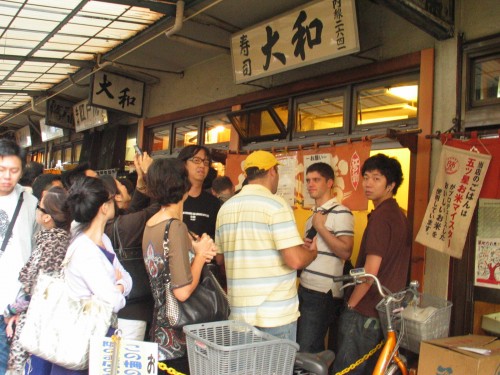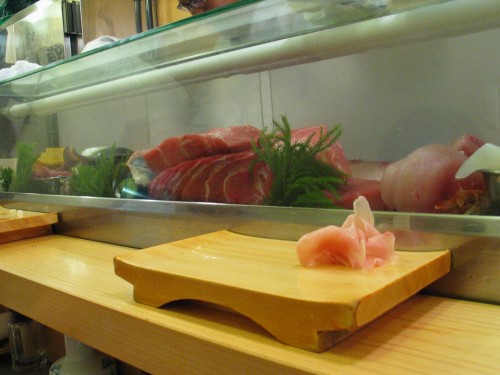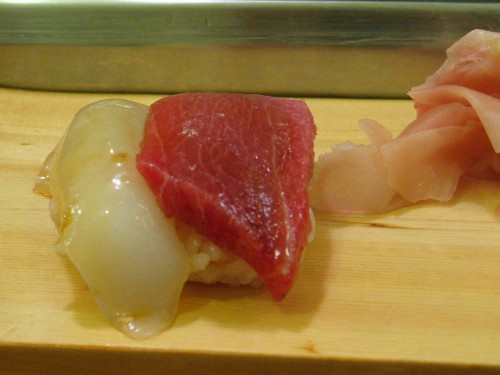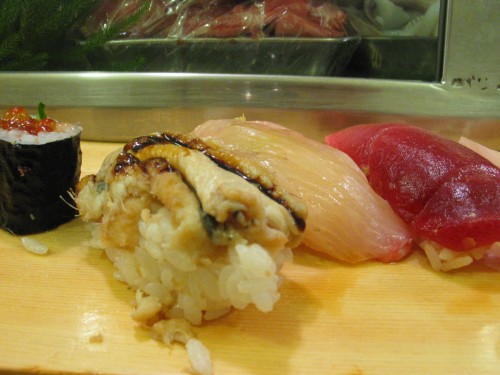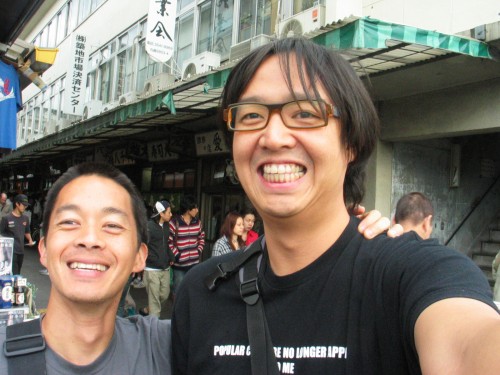If you read the first Tokyo food page, you’re aware of all the oishii food that I ate. But I left out one key meal. In terms of experience and gustatory satisfaction, this was the best meal of all. In short, it was revelatory. Yes, I’m talking about the sushi.
Let me start at the beginning. My friend Minori, a Tokyo native and a champion tofu eater when she was living in LA, said the one thing I could not miss in my visit to her home town was a trip to Tsukiji, the most famous of Tokyo’s wholesale fishmarkets.
So, Ahmad, my buddy and host in Tokyo, and I took the first subway from his place at 5:15 AM to Tsukiji station. With each stop the train gradually filled with early morning commuters and all night partyers. Both groups seemed rather sleepy, but you could tell who the partyers were because they were were the ones passed out ass up on the train.
When we got to the market at around 5:45 there were already hungry people lined up outside the tiny sushi bars leading up to the entrance of the market. It was like the Meatpacking district in Manhattan on a Saturday night, but instead of cheesy dudes and chicks trying to get into cheesy clubs, it was diehard Japanese folks and tourists jones-ing for their fix of morning sushi. Clearly these people had their priorities straight. Being an all around good guy and because he’d been to Tsukiji numerous times, Ahmad volunteered to wait in the hour long line while I took a gander of what was going on in the market.
Tsukiji is well known by locals and tourists as the place to witness the early morning tuna auction known as “seri”. Basically prospective buyers gather in the auction halls where giant frozen tuna are laid out on pallets like mini torpedoes.
Before the auctioning actually starts, the men (and they were all men) use their picks to sample bits of the tuna from the sawed off tail sections. They take the little chunks of meat and rub them between their fingers apparently gauging the fat content, consistency and quality of the meat. These guys know there shit and it was fascinating to watch. From what I gathered, a lot of the wholesale buyers work for the numerous venders at the market who take the tuna, cut it into smaller portions and prepare it for retail sale to food markets and restaurants in Tokyo, other parts of Japan and internationally. Check out these short videos of the auction action as well as one fish monger who knew a thing or two about eels.
Alright, so let’s get back to the sushi. When I got back to the restaurant, Ahmad was near the front of the line so I cut in behind him (exploiting my God given right as a Chinese person). Within a few minutes we were ushered into the tiny sushi bar where the sushi chefs worked tirelessly producing mini masterpieces of sushi art to voracious customers who polished them off in seconds. Various types of fish, fresh from the market were enclosed in a glass case right right in front of us.
To make it easy we ordered the set menu (3500 yen each or about $35) and sat back and let the chefs do their thing. It was a constant flow of various nigiri (slab of fish on a roll of rice) and maki (fish and rice wrapped in nori or seaweed): tuna, yellow tale, squid, salmon roe, sea urchin, eel, shrimp, etc.
To be honest, I’m not exactly clear on all the types of fish I was eating with each piece of sushi because I’m really not that schooled in sushi terminology and quite frankly, I was suffering from sensory overload. Quite simply, every type of sushi I had was the best of that type of sushi that I’d ever had. I had to close my eyes to hold back the tears and to more fully channel my sensory energy to my taste receptors in order to fully appreciate the dynamic interplay of textures and flavors going on in my mouth. It was a revelation.
Let me put it this way. Along with the well known tastes of sweet, salty, sour and bitter, there is a fifth taste component that has more recently come to light though it’s been a component in various culinary traditions for centuries: savoriness. The Japanese call it “umami” or deliciousness. It was a Japanese scientist who first isolated umami and traced it to glutamates, certain amino acids that are found in a variety of often protein rich foods. He eventually developed MSG (Monosodium Glutamate) which is used as a flavor enhancer in a variety of Asian foods. One could say it’s the underlying foundation that ties the other tastes together so that certain foods have a depth of flavor, round and full that envelopes the whole mouth. As I slowly chewed my last piece of toro sushi (ordered a la carte after the set menu, as kind of a dessert – great call, Ahmad!) I was really understanding the true nature of umami. The sharp saltiness of the soy sauce gave way to the rich and dense but delicate meatiness of the fatty tuna whose flavor grew more complex with each chew as if a symphony was crescendoing in my mouth. But alas, the music must end. And as I swallowed I was left with the slight sweetness of the sushi rice, a perfect end to the profound experience that had come before. It was beautiful. This sushi meal gave me renewed appreciation for the simplicity and elegance Japanese cuisine: how combining one key ingredient of the best quality and freshness with a few supporting players can yield transcendent results. Man, is it going to be hard to go back to eating mediocre and overly done up california and caterpillar rolls.
But Ahmad and I weren’t thinking about that when we walked out of the sushi bar. Really, we were just high on having eaten the best fucking sushi at seven in the morning. Life doesn’t get any better than that.
Please check out more photos of Tsukiji Fish Market and Tokyo.


